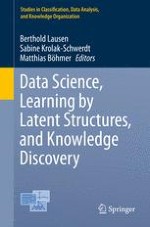2015 | OriginalPaper | Buchkapitel
Ensembles of Representative Prototype Sets for Classification and Data Set Analysis
verfasst von : Christoph Müssel, Ludwig Lausser, Hans A. Kestler
Erschienen in: Data Science, Learning by Latent Structures, and Knowledge Discovery
Verlag: Springer Berlin Heidelberg
Aktivieren Sie unsere intelligente Suche, um passende Fachinhalte oder Patente zu finden.
Wählen Sie Textabschnitte aus um mit Künstlicher Intelligenz passenden Patente zu finden. powered by
Markieren Sie Textabschnitte, um KI-gestützt weitere passende Inhalte zu finden. powered by
